#amateur astronomers
Explore tagged Tumblr posts
Text
Capturing the "Beauty of the Universe" Astrophotography with Small Telescopes
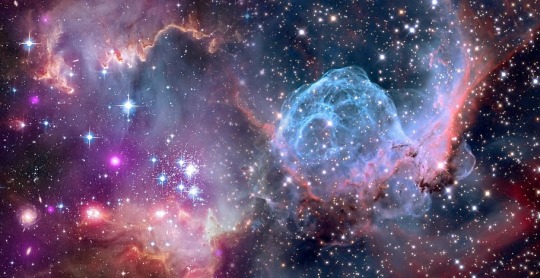
Astrophotography with small telescopes is an excellent way for amateur astronomers to capture stunning and detailed images of the universe. This form of photography involves taking images of celestial objects such as planets, stars, galaxies, and other deep-sky objects using a small telescope.
The process of astrophotography with small telescopes involves attaching a camera to the telescope and then using the telescope to track the object being photographed. This allows for long exposure times which are essential for capturing the faint light emitted by celestial objects.
Benefits of Astrophotography
One of the benefits of astrophotography with small telescopes is that it is accessible to a wide range of amateur astronomers. Small telescopes are affordable and easy to use, making them a popular choice for those who are just starting with astrophotography. When it comes to astrophotography with small telescopes, there are several different techniques that you can use to capture stunning images of the universe.
For example, planetary photography involves capturing detailed images of planets such as Jupiter, Saturn, and Mars. Deep-sky astrophotography, on the other hand, involves taking images of galaxies, nebulae, and other deep-sky objects.
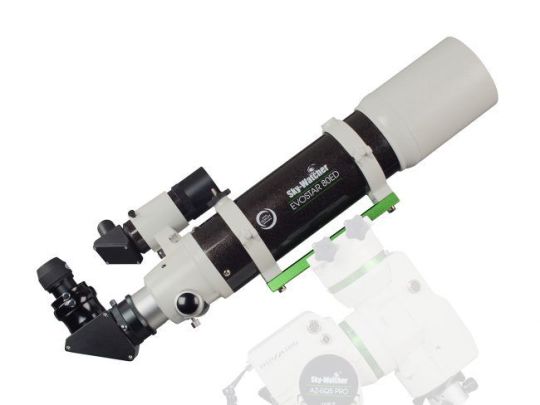
Good Quality Telescope
To get started with astrophotography with small telescopes, you will need a few essential pieces of equipment. A good quality telescope, mount, and camera are all essential for capturing high-quality images. Additionally, you may want to invest in filters, which can help to enhance the details of your images.
Explore the Universe
Overall, astrophotography with small telescopes is a fantastic way for amateur astronomers to explore the universe and capture stunning images of celestial objects.
Whether you are interested in planetary photography or deep-sky astrophotography,there are many different techniques that you can use to capture the beauty of the universe. So, if you are passionate about astronomy and are interested in exploring the universe, astrophotography with small telescopes is an excellent hobby to pursue.
https://whitestaroutdoors.com/2023/06/10/astrophotography-with-small-telescopes/
#amateur astronomers#astrophotography with small telescopes#planetary photography#taking images of celestial objects
0 notes
Text
saw a meteor go right through the center of the aurora my very first time ever seeing it
25 notes
·
View notes
Text
Hello there, I am a space nerd, a fact I’m sure no one guessed from the fact that I go by Stars on the internet. I am here to explain how the moon works, because I think it’s cool and also something that most people don't know. This is mostly an infodump just for fun, but may also be vaguely useful for artists, writers & stargazers.
By “how the moon works,” I mean that although pretty much everyone knows about the moon’s phases, not everyone really gets how they affect things like when & where the moon is in the sky. See: the common idea that the sun is in the sky in the day, and the moon is in the sky at night. You know this isn’t strictly true if you’ve ever seen the moon in the sky in the daytime, but do you know how it actually works? If I gave you a moon phase and a time of day, would you be able to tell me whether the moon was in the sky or not?
I am here to (hopefully) explain how you can do that! With scribbly diagrams! Please join me under the readmore if you would like to come to my TED talk.
First of all, to avoid any accidental curse-of-knowledge assumptions on my part, let me define some terms!
First off, the phases of the moon, which you probably know most of, but bear with me. A “full moon” is when the moon is fully illuminated and appears as a circle in the sky. A “gibbous moon” is when the moon is more than half full, but not completely full—it appears large and roundish, but not a circle (not everyone knows the name for this one). A “half moon” is when the moon is half illuminated and appears as a semicircle—this one has some other names that I’ll get to in a second. A “crescent moon” is when the moon is less than half illuminated and appears as a concave curve. A “new moon” is when the moon is completely dark from Earth’s perspective and can’t be seen in the sky.

Also, “waxing” is when the moon is transitioning from new to full, or getting bigger in the sky, and “waning” is when the moon is transitioning from full to new, or getting smaller in the sky.
Speaking of “half moon,” I frequently confuse friends by calling this a “first quarter” or a “third quarter” moon. Those names refer not to the illumination of the moon but to the full cycle of phases. If you think of the moon phases as split into four quarters, starting from zero at a new moon, then halfway to full is 1/4, full is 1/2, halfway back to new is 3/4, and then we’ve reached the end/beginning of the cycle with another new moon. So one of the half moons is a first quarter moon, and the other (with the other half illuminated) is a third quarter moon.
This is where I have to add a disclaimer—I am in the northern hemisphere, and I am familiar with astronomy in the northern hemisphere. If you are in the southern hemisphere, to you, I am looking at the moon “upside down.” Yes, really. If you’re using my diagrams, flip them upside down. I’ll try to be clear when I’m talking about stuff that flips between the hemispheres, but it’s something that I struggle to wrap my head around too, so apologies if I’m confusing or miss something.
So, here’s a diagram of the moon phases to show you the difference between first and third quarter moons, but if you’re in the southern hemisphere, please flip it over to see what they would look like for you. (The chronological order still goes in the same direction as the arrow, the moon itself is just the other way in the sky.)
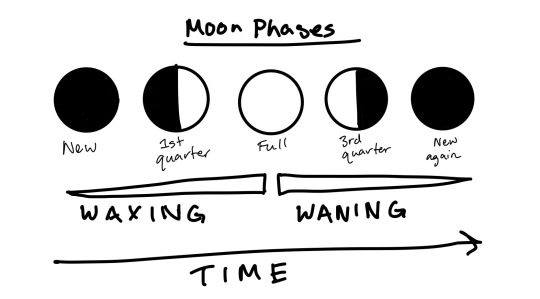
The fun trick I was taught to remember which way the cycle goes is “light from the right.” (Southern hemisphere people, you’ll have to flip this one.) Light, or shadow, moves from the right edge of the moon to the left. So if the moon is a crescent and the right edge is lit up, it’s waxing, or moving towards full. If the moon is a gibbous with a dark right edge, it’s just past full and will be waning towards the third quarter over the next few days. If you look at the diagram above (and imagine the crescent and gibbous phases transitioning in between), this might be easier to imagine.
Like I said, for the southern hemisphere this would actually be “light from the left.” If you’re near the equator and the moon is overhead, you could use “light from the west,” because that’s secretly the real rule. Another thing that’s useful to know for stargazing—the moon, sun and planets follow a path in the sky called the ecliptic, which is roughly over the equator. (Not exactly—it wiggles around relative to earth’s surface, because of the tilt of the earth’s axis that causes the seasons, but it stays near the equator.) If you’re standing in the northern hemisphere, the equator is south of you, so the ecliptic is also in the southern part of the sky. When you look at the moon, it will always be in the south, so the west-facing side of the moon will always be to your right. Likewise, if you’re in the southern hemisphere, the moon (and sun, and planets) will always appear in the northern half of the sky, so west will be to your left. Light moves across the moon’s surface from the west to the east.
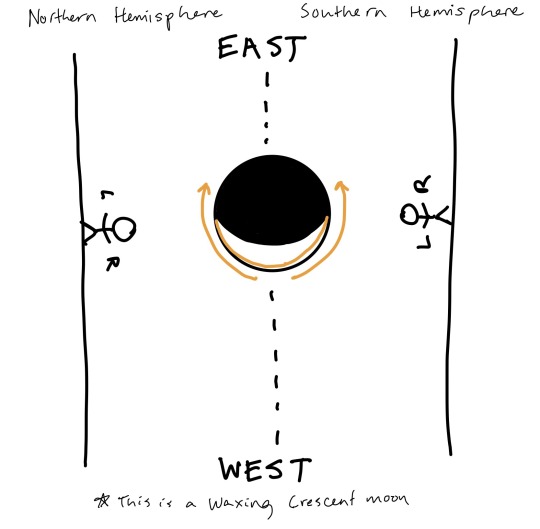
Now you can impress people by looking at the moon and saying, “Oh look, what a lovely waxing gibbous!” (I don’t actually know if the is impressive, but I do it all the time. For bonus points, get an app on your phone that tells you the phase of the moon and check it frequently so you can plan when to stargaze. Then you can casually mention that the moon will be full in a couple days when it’s not even in the sky, and maybe people will think you’re a werewolf.)
Now that I’ve explained the moon’s phases, I get to explain how they’re related to the time and place that the moon is in the sky. See, most people (I assume) don’t think twice about things like, say, a book describing a crescent moon in the sky overhead at midnight. But that actually can’t happen! And it has to do with the moon’s position in the 3D solar system, and how that maps onto our sky. This is kind of hard for me to explain without a lot of 3D hand gestures and pointing at the sky, but I’m gonna do my best to show it in two dimensions.
So, most people probably know that the moon’s phases are caused by the sun’s light illuminating half of the moon, and since the relative positions of the moon, sun & earth change throughout the month, the half that’s illuminated moves around the moon and changes how it looks from our viewpoint. So, a very basic rule: the side of the moon that’s illuminated is the side that’s facing the sun.
So, when the moon is full, that’s because the side that faces us is also facing the sun. This means the sun is directly opposite the moon. Here’s a very scientific diagram:
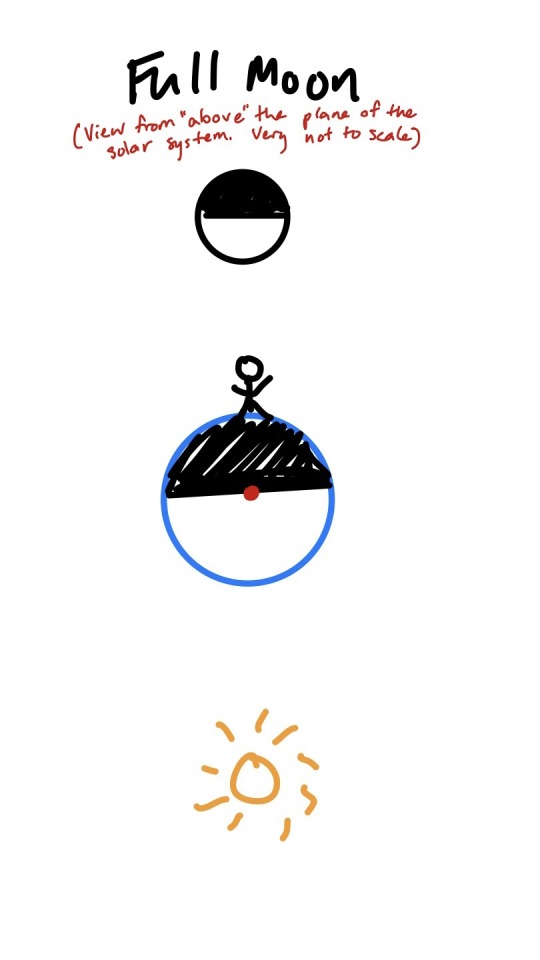
In case it’s not clear, this is a “top-down” view of the solar system where the moon, earth and sun are all in the same plane (in this case it doesn’t matter if we’re looking at the north or south pole, the positions would look the same). It’s also obviously not to scale and very simplified, but the point is to demonstrate that the moon is opposite the earth from the sun.*
The little person on the earth is of course spinning around as the earth rotates once per day. But at this point in the lunar month, you can see that when they are on the side of the earth where they can see the moon, they are also on the side facing away from the sun. When the moon is full or close to full, it’s opposite the sun—it rises around sunset, sets around sunrise, and is at its peak in the sky around midnight. This is how lots of people tend to think of the moon rising and setting, but it’s only true when the moon is close to full!
If that doesn’t make sense, here’s a diagram of when the moon is at the opposite point in its cycle, a new moon:

When the moon is new, the side that faces the earth is dark, which means the opposite side is facing the sun. The moon is on the same side of earth as the sun is. The little person spinning around the earth won’t see the moon in the night sky, because the moon is close to the sun in the sky,* and it’s actually rising in the morning and setting in the evening at this time of the month! You can’t easily see the moon when it’s new, but it might be visible a few days before or after this as a crescent. You’ll only see a crescent moon in the sky during the day, or close to dawn/dusk—it will be close above the horizon where the sun has just set or is about to rise. (The light edge faces the sun, so if it’s near the horizon in twilight sometimes it will look like the light edge is actually pointing down, with the tips of the crescent pointing up in the sky.)
*A side note on eclipses: My diagram is oversimplified! The moon, earth and sun aren’t actually all in the same plane all the time, they’re slightly misaligned. So even when I say the moon and sun are “directly” opposite each other, or aligned, they aren’t lined up perfectly enough to cast shadows on each other most of the time. When they do line up perfectly at the right time, that’s when you get a solar eclipse (when the moon is new) or lunar eclipse (when the moon is full).
Okay, so when the moon is full it’s in the sky at night, and when the moon is new it’s in the sky during the day. What about in between? This is where it gets a little confusing, especially for those of you in the southern hemisphere, who are going to have to flip everything I say. Apologies in advance, but it kind of hurts my head even to explain how this works in my own half of the sky.
So, when the moon is half-full, at the first quarter and third quarter of the phase cycle I explained above, the sun’s light is coming (from our perspective) from the side. The moon is ninety degrees away in its orbit from full or new, and the sun’s light is effectively perpendicular to our viewpoint, instead of parallel. This time it matters which way we’re looking, so these are a top-down view from the northern-hemisphere side. If you’re in the southern hemisphere, I think you can flip which is the first & third quarter to make this accurate.
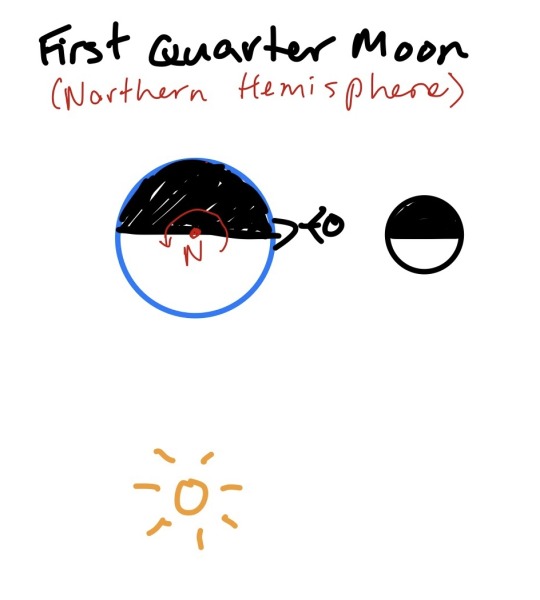
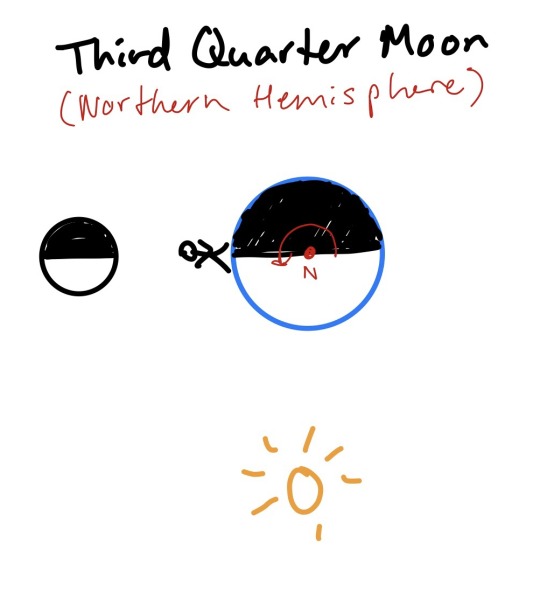
As you can see, when our little person is spinning around the globe, they’re going to be seeing the moon high in the sky right around the line between night and day. From a northern perspective, the earth spins counter-clockwise (vice versa from the south), so if you picture the person spinning around their little earth, you can see that the first quarter moon is going to be visible when they’re spinning from light to dark (sunset) and the third quarter moon is going to be visible when they’re spinning from dark to light (sunrise).
Bonus fun trick: If you remember the rule of “light from the right” in the northern hemisphere and how that determines the order of the phases, and look at these diagrams again, you can figure out which direction the moon orbits the earth from this viewpoint. (This is, in fact, the only way I can remember which direction the moon orbits the earth, despite being far more complicated than just memorizing it. If you’d like to make a game of it, I’ll put the answer at the bottom of the post).
Remembering how this looks from this top-down floating-above-the-earth perspective is hard, but you don’t really have to. I only explained it so it would make sense when I went back to my earlier visualization, from when I was explaining how “light from the right” works. I’m a very spatial learner, and I like picturing things relative to my own body, so this is how I remember when the different phases of the moon appear in the sky:
Imagine you’re standing, facing the ecliptic, where the sun and the moon travel through the sky. In the northern hemisphere, you’re facing south, with east to your left and west to your right. Imagine that the sun has just set, falling beneath the horizon to your right. Imagine that the moon is full, and hopefully I’ve explained well enough that now you know where it will be—cresting the horizon at your left. Imagine the opposite too—the sun is rising in the east at your left, as the full moon sinks in the west at your right. The new moon’s position, if you’d like to visualize that, is effectively the same as the sun.
Now, the difference between the two half-moons. Light comes from the west—in the northern hemisphere, your right—so when the right half is illuminated, it’s the first quarter of the lunar month, waxing to full, and when the left half is illuminated, it’s the third quarter, waning to new. One is high at dusk and one is high at dawn. Which is which?
You’re facing south. Picture a first quarter moon, right side lit up, at its peak in the southern sky. The light side is always facing the sun. Where is the sun? It must be to your right, touching the horizon in the west, setting. The first quarter moon is in the sky before, during and after dusk.
Picture a third quarter moon, left side lit up, at its peak. The light side faces the sun. The sun is to your left, touching the horizon in the east, rising. The third quarter moon is in the sky before, during and after dawn.
When I imagine this, I’m standing on my back porch, where I often go outside and stargaze. My telescope is small and one of the few things it can see with any detail is the moon. I want to be able to look at the moon just after dark, without having to stay up too late—and this memory device, of facing south and imagining the sun at my right hand to the west, is how I remember that the first quarter is the best time for me to observe the moon. It will be high in the sky at sunset, easy for me to see over the houses and trees.
If you remember that the moon waxes and wanes from the west (right in the north, left in the south), then you can fill in all the gradations of crescent and gibbous moon between the four main quarters. (As an example, if I wait a few days past first quarter to go outside and look at the moon, it’s waxed into a gibbous moon and it rises later in the evening, peaking in the sky closer to midnight. Another example: a waxing crescent is between a new moon and first quarter, so it will trail behind the sun and be above the horizon in the southwest at sunset.)
I hope that all of this makes sense and is useful to someone, whether for figuring out when you can observe the moon and where in the sky to look, or for thinking about how to place it in the sky in your writing and art. If nothing else, I hope I have brought you entertainment, and/or ruined the way the moon works in Minecraft for you forever. (It rises and sets directly opposite the sun!! Even when it’s a new moon!!! Light doesn’t work like that!!)
And finally, if you were trying to guess, the moon orbits the earth counter-clockwise if you’re looking down from the northern side.
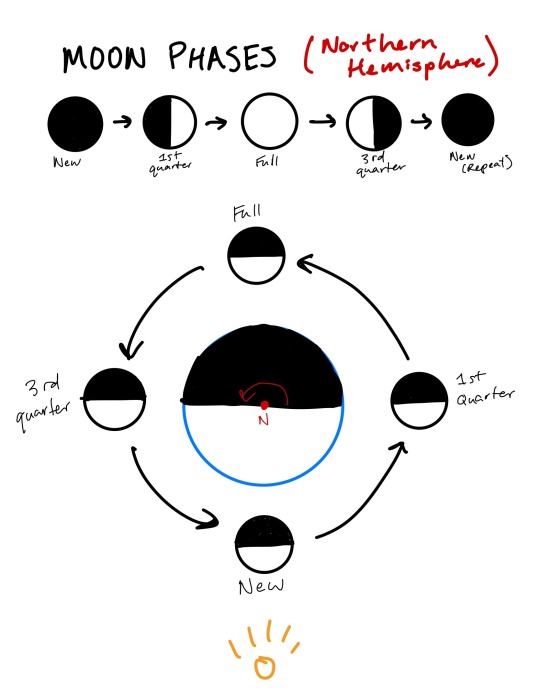
#stars has thoughts#space#the moon#amateur astronomy#thank you for coming to my ted talk#and thanks discord friends for saying 'write the moon infodump post!!'#when i was like 'i wonder if i should write a moon infodump post'#i am a humble space nerd slash backyard astronomer with a 4inch scope#but explaining how i visualize and remember space stuff in simple terms is one of my favorite things to do ever#i could do a bunch of other posts about stuff like this. why venus is the morning star. how telescopes work (explain it like i'm 5 edition)#perhaps i will#undescribed#(i will try to come back with image descriptions later but i have already done all the explaining of visual concepts with words#that i can manage today. apologies)
71 notes
·
View notes
Text
Quick question
How do you feel about Starlink and Space-X?
#astronomy#space#amateur astronomy#astronomer#satellite#space-x#elon musk#starlink#science#technology#opinions#poll#tumblr polls
8 notes
·
View notes
Text
I LOVE SCIENCE EDUCATORS
#retired old dudes (gender neutral) who are extremely passionate about their field#bugs or astronomy or whatever#my BELOVEDS#i just made a new friend can u tell :D#we tag-teamed telling ppl about astronomy tonight#he def knows more than me but has a hard time recalling words sometimes#and i know just enough to be able to chime in when he forgets something to give vocab or clarification#he's mostly a bug guy professionally but he's an amateur astronomer#we were supposed to b showing ppl the moon tonight but there were suddenly too many clouds ;-; weeps#anyway im home now and im fucking. BUZZING. with energy#i think im an extrovert but only for science communication#so maybe im just autistic. lmao.
6 notes
·
View notes
Text
not my squiddy ass procrastinating on drawing by looking up pictures of tuvok
#apparently tim russ is an amateur astronomer as well as a massive trekkie. that checks out#text tag
3 notes
·
View notes
Text

SCIENCE PAGES ⚛️ ♒️ ♾️ ✨️
Amateur Astronomer Group USA
0 notes
Text

0 notes
Text
Amateur Astronomers Help Discover Cosmic Crash
Astronomers found what looks like a glowing cloud of dust from a massive planetary pile-up—and NASA volunteers helped make the discovery! from NASA https://ift.tt/0B3W8Zp
0 notes
Text


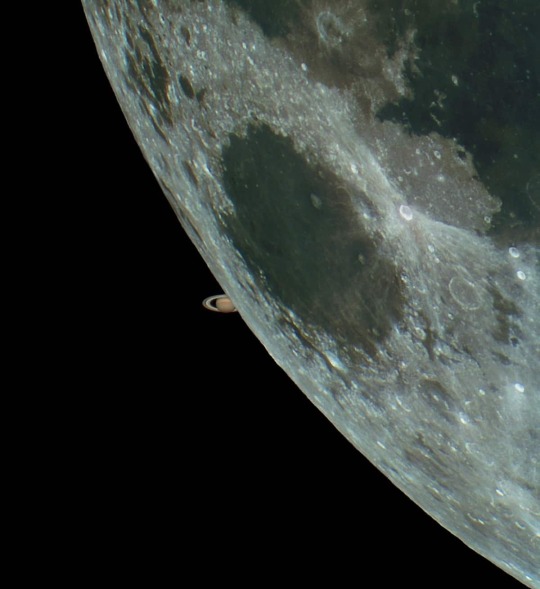
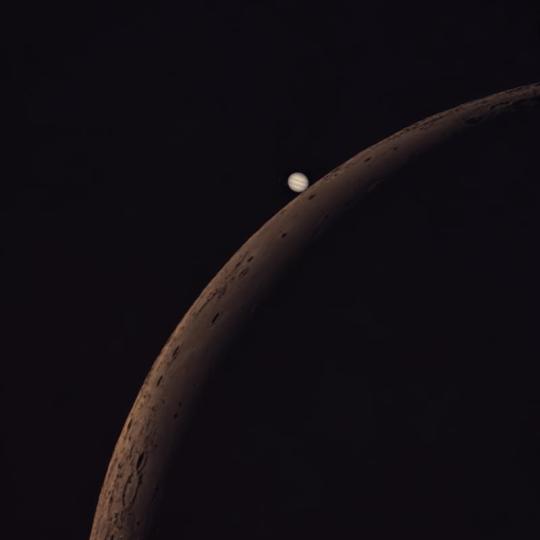
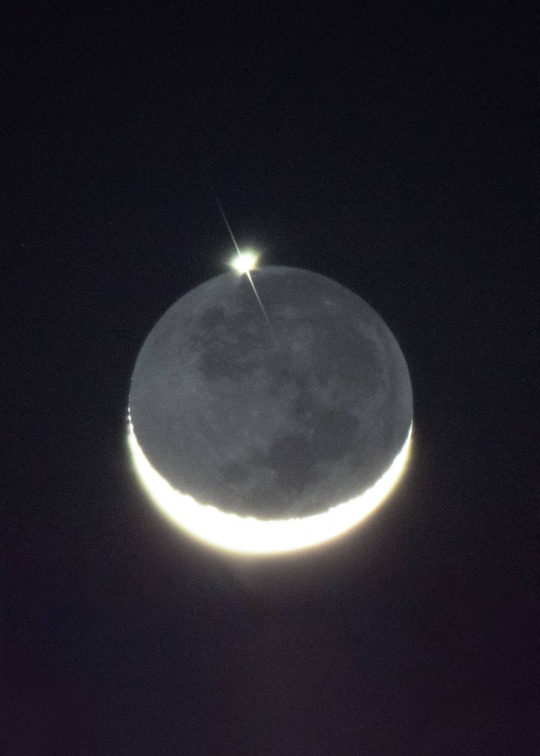
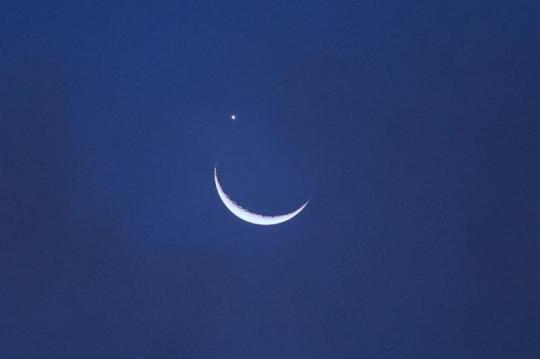
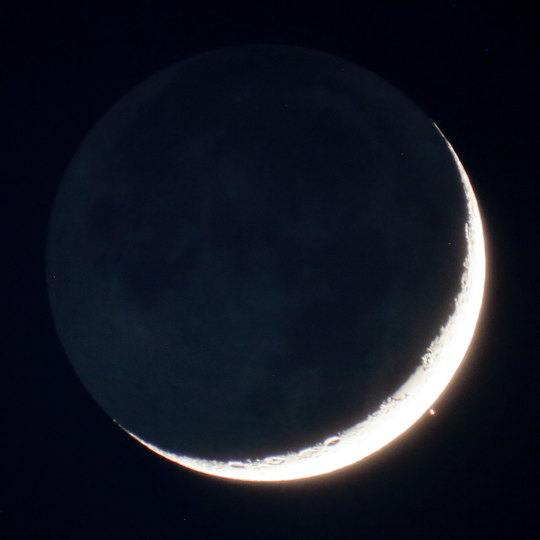
Occultations by the Moon
The term occultation is most frequently used to describe lunar occultations, those relatively frequent occasions when the Moon passes in front of a star during the course of its orbital motion around the Earth. Since the Moon, with an angular speed with respect to the stars of 0.55 arcsec/s or 2.7 μrad/s, has a very thin atmosphere and stars have an angular diameter of at most 0.057 arcseconds or 0.28 μrad, a star that is occulted by the Moon will disappear or reappear in 0.1 seconds or less on the Moon's edge, or limb. Events that take place on the Moon's dark limb are of particular interest to observers, because the lack of glare allows easier observation and timing.
The accurate timing of lunar occultations is performed regularly by (primarily amateur) astronomers. Lunar occultations timed to an accuracy of a few tenths of a second have various scientific uses, particularly in refining our knowledge of lunar topography.
source
image credit: Tom Fleming, Elias Chasioti, Delberson Souza, Bob Schiff, Fausto Lubatti, Sergio Scauso
1K notes
·
View notes
Photo




Born #onthisday in 1827, the French astronomer, artist, and amateur entomologist Étienne Léopold Trouvelot. See a collection of his stunning astronomical art here: https://publicdomainreview.org/collection/the-trouvelot-astronomical-drawings-1882 #otd
(And prints to buy here: https://publicdomainreview.org/collection/the-trouvelot-astronomical-drawings-1882
84 notes
·
View notes
Text
thinking about boxer! stelle’s who is pretty much emotionless and just likes to fight. she’s basically an amateur boxer who’s popularity quickly grew because of her innate ability to adapt to seemingly anything. there’s so many gyms wanting to recruit her, even pro gyms that amateur boxers would do anything to get accepted to. stelle ends up going to ‘set your trail ablaze’, a very promising gym with plenty of aspiring and famous boxers.
she meets you there and oh boy, you gave that girl so much color and shine to her eyes as her relationship with you develops. a lot of the members, esp the coaches (himeko, herta, welt, & etc), was pleasantly surprised about stelle’s transformation! at first, she barely spoke and attended practice without interacting with anyone, and everyone was trying to get her to talk to them but to no avail. then you, a newbie trainer to the gym, who’d give her company despite her nonchalant looks and side glances towards you. you were unbothered by her stoic nature.
“ that’s good, stell’ but your jab’s a little wide—which is fine since you have long arms but because of that, you tend to come back a little slow. you gotta be a tiny bit faster and quickly go back into stance like—. “ before you could step up and show her, she sliently does it, swiftly jabbing and snaps back into her boxing stance with perfect execution. she then looks at you expectedly.
“ yeah, atta girl. that’s perfect, geez, i didn’t have to demonstrate for you! “
“. . .” she nods at you before waiting for your next instructions, ignoring the fluttering feeling in her stomach.
you became stelle’s unofficial personal coach and trainer, helping her improve as both a boxer and a person from your strong support. she grew more comfortable around you and others, becoming a little more vocal and expressive. she now has a habit of following you around like a puppy whenever you’re present in the gym. she’ll visibly sulk and become a little distracted when you’re not there. it was clear to everyone except you that she has a crush on you. you also have a crush on her, i mean, she reminded you of a adorable raccoon with claws! the obvious romantic tension between you and stelle was so agonizing, it was driving the fellow gym members crazy.
it was until stelle’s first pro boxing match where she was getting surprisingly overwhelmed by the other opponent. she looked completely beaten up and worn out, it broke your heart. during the one minute resting period, you were so full of frustration that you splashed water on her bruised face, aggressively patted her cheeks, then squished them together and pulled her into a searing kiss that left everyone in the ring and the audience speechless.
“ i fucking love you stelle but, if you don’t get your tall ass up and win, i’ll take it upon myself to be your sparring partner in every sparring match you do. “
spoiler alert, she indeed got her ass up with astronomically high spirits. a dark shade of red staining her cheeks, an odd, dopey grin plastered on her swollen, busted lips—yeah, she’s ready to kick ass in the name of love.
she totally did.
#trendy#honkai star rail women x reader#stelle x reader#new auuuuu guys#i’m cookin againnnn#boxer! stelle can dom me#boxer! au
313 notes
·
View notes
Text
My steddie brain never rests. And neither will I!! Bwahahahaha! *cough cough* Sorry about that.
Eddie is a pirate captain. He is a known terror of the Seven Seas. His ship The Hellfire is known by its fearsome Jolly Roger. The skull has devil's horns and has a cutlass and musket on either side.
His first mate is Jeff and his cabin boy is Dustin.
He has a very dedicated crew. They are loyal to a fault and fiercely protective of their captain.
He is a thorn in the side of Lt. Jason Carver. The man tasked to bring him in.
Eddie has been captured a few times, but always his crew mounts a daring escape.
Final Eddie is caught and Carver isn't going to wait until morning to hang him and give his crew time to save him. He knows he'll catch hell for it later, but Eddie must be stopped.
When Carver comes to get him, he finds Eddie looking out the window at the night sky.
"Praying, Munson?" he sneers. "I didn't think your kind believed in God."
Eddie shakes his head. "No God. I worship starlight."
"Starlight?" Carver mocks. "What's so special about starlight?"
"When the moon is new and the stars stretch on forever," Eddie explains a little breathless, never taking his eyes from the window high above him, "you can find your way if you let the North Star lead you. That's what I believe in. The North Star."
Carver scoffs. "You sound like you're in love with a distant twinkle, Munson. I always knew you were mad, but this takes the cake."
Eddie shakes his head ruefully. "Oh that I could love a star, that it could love me back."
Carver motions to his men and they haul him to his feet.
They take him out to the scaffold where the noose is waiting for him. They put the rope around his neck and he whispers. "Goodbye, sweetheart."
Tears run down his face as they tighten the noose. He closes his eyes.
But before they could pull the handle that would send Eddie plummeting to his death a bright light appears blinding everyone but Eddie because his eyes were closed.
He feels a soft warm hand touch his cheek. "Keep your eyes closed for me, won't you?"
Eddie nods. He doesn't know what's going on but even through his eyelids he can tell the light is too bright.
Suddenly there are sounds of screaming and of people being ripped apart. Eddie squeezes his eyes further shut.
Then the rope is being removed from his neck. "Don't open your eyes yet, love," the warm voice murmurs in his ear.
Eddie shivers but not because of the chill of the night, but because the voice sent a sharp thrill straight to his gut.
Then he's being picked up and carried bridal style. Whoever this is keeps telling him he's all right, that he's safe now.
He get set down gently on his feet.
"You may open your eyes now."
And Eddie does only to be greeted by the most ethereal being he's ever seen.
His hair is dark brown with golden highlights and he has hazel eyes. He's wearing robes that shimmer in the light and he gives off a subtle glow.
"Thank you," Eddie murmurs.
The man gives him a gentle kiss. "I will always watch out for you, my beloved Eddie."
"What's your name?"
"Stella Polaris."
Then in a flash he's gone. He makes it back to his ship and tells them the tale.
They don't believe him at first but whenever a battle is turning against them, a light flashes, blinding their enemies and ensuring their victory.
Eddie makes it back to England and is talking to a scholar, getting the old man drunk in a bar.
He says he's an amateur astronomer and Eddie pumps he for information because of his own love of the stars. And he brings up the North Star.
"Ah," the old man says with a nod. "Stella Polaris, the star that is polar. The one star in the sky you can always rely."
And Eddie is floored. His rescuer was the actual North Star.
That night laying in bed at the inn, Eddie says, "My own star. Well, I'll be damned."
Then Stella Polaris arrives in his room.
Eddie leaps from the bed and kisses him senseless.
"Stella Polaris is a bit of a mouthful for every day, sweetheart," Eddie murmurs between heated kisses. "What should I scream when you fuck me?"
The star laughs. "You can call me Steve."
"Well, come on, then, Stevie," Eddie coos wagging his eyebrows. "The night is young and I have been aching for you since you rescued me."
They tumble into the bed and have sex. The next morning comes, and Eddie wakes up to find a small little starburst scar just a above his heart that he'll later get tattooed.
For the star that fell in love with a pirate and the pirate who loved it back.
197 notes
·
View notes
Text

This is Grey, my other Outer Wilds OC!
They are the Head of Tech support for Outer Wilds Ventures, and work alongside Nephrite. They're also an amateur astronomer who has their own small telescope. They are friendly, calm, and easy to get along with.
Grey is very skilled in computer tech, especially programming.
They are Nephrite's "boss", best friend, and favourite Hearthian.
I'm steadily working through OC art requests, so if you've asked me for an OC drawing, don't worry! I haven't forgotten you ;;)
61 notes
·
View notes
Text
Worldbuilding: Something I Learned About Planetary Surface Gravity
Last year (hehe; it's always fun to say that at the start of a new year; actual time about 4 months ago), I made a strange discovery!
I won't slow-roll you. Here's the bottom line: In reality, i.e. based on observational data, there appears to be a plateau of surface gravity for planets up to about 500 times more massive than Earth. Most planets between 1 Earth mass and ~500 Earth masses have a surface gravity that is close to our own, i.e. 1 g. So if you're worldbuilding, and need a planet with a surface gravity that is more than a few percentage points higher than Earth's, be careful.
All right, on to the story!
I had need of such a planet for Galaxy Federal. About 125% percent or so, i.e. 1.25 g. And it was in the back of my mind that Neptunian planets often have a "surface" gravity similar to that of Earth's. "Okay," I figured, "that's probably because their giant atmospheres reduce the average planetary density. On a rocky world that wouldn't be an issue. But I'd better check to be safe."
Oh, it is always a good idea to check!
I found a paper which was reporting the plateau that I mentioned in the TL;DR. Here's what it looks like:

Gravity vs mass for Solar System bodies and exoplanets. Ballesteros, Fernando & Luque, Bartolo. (2016). Walking on Exoplanets: Is Star Wars Right?. Astrobiology. 16. 10.1089/ast.2016.1475.
What they found is that Super Earths, i.e. rocky planets with a mass greater than Earth's, did not exhibit the increase in surface gravity seen in smaller celestial bodies. There is this "plateau" where increases in planetary mass and radius are such that the surface gravity essentially levels out for a while.
This isn't something I think you could predict from amateur astronomical principles. What you would predict (certainly, what I predicted) would be what we see on the left side of the above figure, where more mass equals more surface gravity. All of the small rocky bodies in our own Solar System fall onto that left side of the graph. The plateau only really begins in the Earth range of planetary mass. You can see how Venus is included in the plateau almost perfectly, but the much less massive Mars is not.
This is a truly remarkable finding about planetary formation, and has serious implications both for fictional worldbuilding and someday for planetary colonization. That is, if these observations are truly representative of the Universe. This is a pretty big "if" that I don't have the knowledge to be able to check, except to say that there may be some bias unaccounted for because of how we detect exoplanets, such that perhaps the ones we detect are not representative of the ones we do not—so take it all with a grain of salt. This paper is 8 years old but I couldn't find anything newer following up on it.
Fully understanding how it would work is still a question mark for me. I mean, it's a question mark for the professional planetary scientists, too, so there's that, but, in addition to the unknowns that curtail their comprehension, there's a lot I don't know about astronomy that further curtails mine. My understanding is that this isn't really about the intrinsic density of the materials (i.e. substances that are more massive or less massive per mole); it would mainly have to be a consequence of how planets form, how the geological processes change in different planetary mass categories; that sort of thing. But I don't really know! I'm out of my depth.
Anyway, you can download a copy of the full paper on its entry page on ResearchGate; look for the button that says "Download full-text." And the website Centauri Dreams has a nice write-up which is where I originally discovered this.
37 notes
·
View notes
Text
Dream Jobs for the Creatively Haunted:
Reclusive Novelist. Writes sprawling gothic novels in isolation, rumored to be a vampire, emerging only to send off manuscripts before retreating into the shadows of a candlelit mansion.
Mysterious Antiquarian: Always found in dimly lit libraries, deciphering ancient scrolls by candlelight, dagger discreetly at hand for "protection".
Melancholic Poet with a Laudanum Habit: Writes verses at midnight, prone to night terrors and sleep-walking.
Occultist & Arcane Scholar: Conducts clandestine rituals, studies forbidden grimoires, and seeks contact with otherworldly entities.
Spiritualist Medium: Hosts late-night seances in candlelit parlors, contacting the otherworldly spirits of loved ones or tragic figures from history.
Tortured Artist: Paints dark, brooding masterpieces while battling personal demons, often found pacing in their paint-splattered studio talking to people no one can see.
Opium Den Proprietor: Runs a smoky, velvet-draped hideaway where melancholics and dreamers come to forget the troubles of modern life.
Eccentric Cryptid Hunter: Spends years traveling the globe in search of mythical creatures, with an air of aristocratic eccentricity and a passion for the bizarre.
Amateur Astronomer: Spends long nights in isolation, gazing at the stars through a brass telescope while crafting cryptic maps of constellations.
Traveling Apothecary: Wanders from town to town selling curatives, potions, and strange herbs while trading in whispered legends of lost cures and magic.
Silent Pianist: Plays hauntingly beautiful music in a derelict theater, with rumors that their audience is made up of long-dead spirits.
Lantern-Lit Fog Guide: Leads travelers through the thick, fog-covered streets of London at night, with many wondering if they guide them to safety or something more sinister.
#writing memes#writer memes#writing#writeblr#writerscommunity#writers on tumblr#writer#writing life#creative writing#on writing#fiction#gothic#victorian#bookblr
58 notes
·
View notes